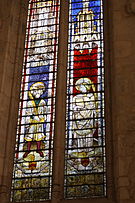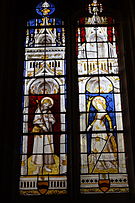Notre-Dame (Ambronay)
The Abbey of Notre-Dame in Ambronay , a commune in the Ain department in the French region of Auvergne Rhône-Alpes , is a former Benedictine monastery in the 9th century. A cultural meeting center (Center Culturel de Rencontre) is now housed in the convent buildings. A music festival dedicated to early music has been held here since 1980 .
history
Ambronay Abbey was founded by Saint Barnard in the 9th century; the religious community adopted the rule of St. Benedict . In the 11th century the abbey owned 44 parishes, 21 priories and nine deaneries . Since it was exposed to the border disputes between Savoy and the Dauphiné due to its location , the abbey was expanded at the beginning of the 13th century with two defense towers and a fortified residential wing. In 1282 it lost its independence when it placed itself under the protection of the Counts of Savoy . Monastic discipline suffered a decline under the commandant abbots.
In 1652 the abbey was attached to the Congregation of Saint-Maur . The Maurinians led the monks back to monastic life, restored the convent buildings and set up a school, an archive and a library.
After the French Revolution , the monastery was secularized in 1791 . The abbey church became a parish church after being briefly converted to the temple of reason (temple de la raison). In 1806 the former parish church of Saint-Nicolas, which stood on the forecourt of the abbey church, was demolished. The convent buildings were sold and used as a barn , prison, hospital, school, barracks or social housing.
In 1889, the abbey church was as a protected monument in the list of Monuments historiques added and the Ain department bought up gradually the former convent building.
The Festival d'Ambronay has been held in the former abbey since 1980, where concerts of early music are performed.
Abbey church
Exterior construction
The church was built in the 13th century. The entrance facade is asymmetrical. The bell tower is on the north side. The small oriel tower on the north side served as a clock tower.
inner space
The church has three aisles . The main and side aisles are covered with a ribbed vault.
In the north aisle there are still fragments of wall paintings from the 14th century. In a wall niche a Pietà is kept, which is dated to the 16th century.
In the church there is the funerary chapel of Jacques de Mauvoisin, the abbot who initiated a major renovation of the abbey in the 15th century.
Leaded glass window
The choir windows date from the 15th century. The crucifixion of Christ is depicted in the middle window, including the Annunciation scene. The side lancets are occupied by two abbots, who stand in splendid regalia under a pseudo Gothic architecture. The lower middle pane is dedicated to the Abbot Jacques de Mauvoisin.
On the side windows of the choir, St. Catherine and the Apostle James and two martyrs are depicted.
Choir stalls
In the 15th century, the choir stalls were made of oak, the cheeks and misericords of which are decorated with figures and grimaces.
Cloister
The two-story cloister is laid out on the south side of the church. The lower floor was renovated in the 15th century. The upper floor was restored after a fire in 1632. The monumental staircase that leads to the upper cloister floor was also created in the 17th century. There is a painted wooden ceiling above the staircase.
The southern gallery was enlarged in the 17th century. The refectory , the dormitory and the kitchens were located here. The supplies were kept in the basement.
Abbot's Palace
On the north side of the church is the former abbot's palace, which was built in the 15th century under the abbot Jacques de Mauvoisin.
Archive tower
The tower was built as a defense tower in the first half of the 13th century.
Dauphine tower
The Dauphine tower was built at the same time as the archive tower, but was dismantled again in 1595 by order of King Henry IV . It was rebuilt towards the end of the 17th century, but no longer at its original height.
literature
- Ambronay information sheet. L'Abbaye.
Web links
- Ambronay (ancienne abbaye) in the Base Mérimée of the French Ministry of Culture (French)
- Abbaye d'Ambronay Center Culturel de Rencontre (French text)
Individual evidence
- ↑ Barnard of Vienne . In: Ecumenical Lexicon of Saints
- ↑ Ambronay (ancienne abbaye) in the Base Mérimée of the French Ministry of Culture (French)
Coordinates: 46 ° 0 ′ 25 ″ N , 5 ° 21 ′ 42 ″ E






